Professional Stainless Steel Wire Mesh Manufacturer and Stockist from China.
Feel free to call or email our senior sales.
+61 435 598 786
+86 158 0318 7372
hello@metartmesh.com

+61 435 598 786
+86 158 0318 7372
hello@metartmesh.com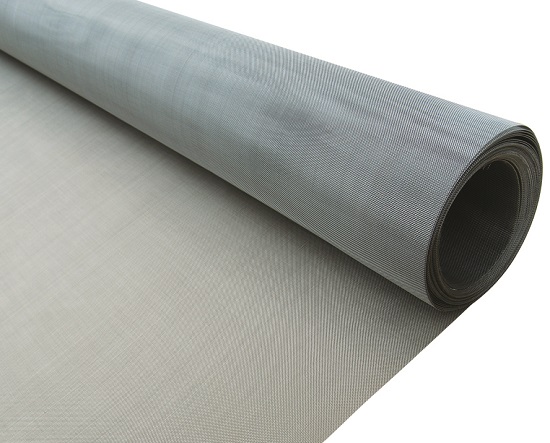
Stainless Steel Wire Mesh and Wire Cloth
Material: SS201, SS304, SS304L, SS316, SS316L, SS309, SS310, etc.
Type: Filtration Wire Mesh
Patterns: Plain & Twill Weave, Dutch Weave, Reverse Dutch, Five Heddle
Mesh Count: 1Mesh to 635Mesh based on different weave pattern.
Wire Diameter: Custom Made
Width: 914mm, 1000mm, 1220mm and other custom other custom made sizes.
Length: Within 30Meters
Stainless Steel Wire Mesh is basically a woven wire mesh that is made of stainless steel wires. The type of raw material can be customized based on the customers' requirements. The most common stock of wire mesh rolls is AISI 304 grade stainless steel wire mesh, common ss304 stainless steel wire mesh, AISI 316 grade stainless steel wire cloth, and AISI316L stainless steel wire cloth. For other commonly used stainless steel grades like 321 grade, and 310S grade, please inquire with us for availability.
When it comes to some lower mesh count coarse wire mesh, it is always called stainless steel wire mesh, and it is also called stainless steel wire cloth when it refers to some really fine wire mesh.
METART usually produces stainless steel wire mesh and wire cloth in rolls in order to keep a regular and diverse stock.
But we can also slit it into small-sized rolls or cut it into smaller-sized wire mesh sheets based on different requirements. Meantime, METART can provide other services including welding, framing, and pickling upon request.
Packing Way: Inner kraft paper, outside the plastic film, and then plywood crates.
Lead time: 5 Days for products in stock. The production time of customized wire mesh needs to be negotiated.
There are six main weave patterns for stainless steel wire mesh and wire cloth.
#1 Plain Weave Wire Mesh
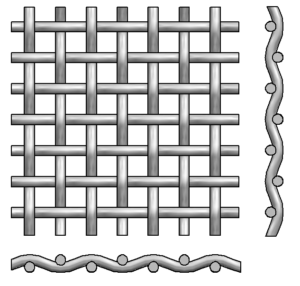 Plain weave wire mesh and wire cloth, also known as square hole wire mesh or tabby weave mesh, is a popular type of woven wire mesh that finds widespread use in the industrial wire fabric and textile weaving industries. The plain weave pattern is characterized by the interlacing of vertical warp wires and horizontal shute wires at a 90-degree angle, resulting in a uniform square hole pattern.
Plain weave wire mesh and wire cloth, also known as square hole wire mesh or tabby weave mesh, is a popular type of woven wire mesh that finds widespread use in the industrial wire fabric and textile weaving industries. The plain weave pattern is characterized by the interlacing of vertical warp wires and horizontal shute wires at a 90-degree angle, resulting in a uniform square hole pattern.
The plain weave pattern is widely used in industrial and commercial applications due to its versatility, durability, and strength. Plain weave wire cloth is commonly used for filtration, screening, and sorting applications in a range of industries, including the chemical, food and beverage, mining, and pharmaceutical industries, among others.
The interlacing of the warp and shute wires results in a uniform and symmetrical appearance, with each wire equally spaced and parallel to one another. This structure ensures the stability and robustness of the mesh, making it an ideal material for demanding industrial applications that require resistance to wear and tear, corrosion, and high temperatures.
In addition to square-hole stainless steel mesh, plain weave wire cloth is available in various mesh counts, both in the warp and weft directions, to form a rectangular-shaped hole to meet specific application requirements. Mesh counts range from coarse to fine, with a finer mesh count providing greater filtration and screening accuracy.
Plain weave wire cloth can be made from a variety of materials, including stainless steel, copper, brass, and nickel, among others, each with different properties that make them suitable for specific applications. For example, stainless steel is resistant to corrosion and high temperatures, making it ideal for use in the chemical and food and beverage industries. Copper is an excellent conductor of electricity and is commonly used in the electronics industry, while Nickel is highly resistant to corrosion, making it suitable for harsh environments such as marine and chemical applications.
In summary, plain weave wire cloth is a versatile and durable material that finds use in a range of industrial applications. Its interlaced pattern ensures a uniform and symmetrical appearance, with each wire equally spaced and parallel to one another. With various mesh counts and material options available, plain weave wire cloth can be customized to meet the specific requirements of a range of industries and applications.
#2 Twill Weave Wire Mesh
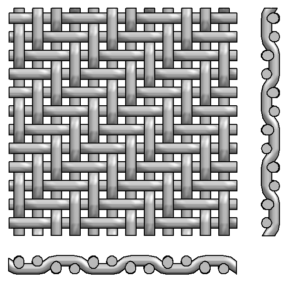
Woven wire patterns play a crucial role in the industrial sieving and filtration mesh industry. Among the different wire patterns available, the twill weave mesh pattern stands out as the second most widely used after the plain weave pattern. Unlike plain weave wire mesh, twill weave mesh involves a more complex weaving process, which results in a diagonal pattern on the surface of the mesh.
To create the twill weave wire pattern, the shute wire in a horizontal direction passes over two warp wires at the same time and then goes down under another two pieces of warp wires alternatively and vice versa. The result is a twill weave mesh with a diagonal pattern, which provides a more robust and durable wire mesh compared to plain weave wire mesh.
One of the advantages of the twill weave wire pattern is that it offers a possibility for some specific mesh counts that require a bigger wire gauge but cannot be achieved by a plain weave pattern. Thus, the twill weave wire screen provides a higher loading capacity and finer aperture, which can't be achieved by the plain weave mesh pattern. This feature makes twill weave mesh ideal for applications that require high precision and filtration performance, such as in the pharmaceutical, food, and chemical industries.
Overall, the twill weave wire mesh pattern offers a significant improvement over the plain weave pattern in terms of robustness and filtration performance. This makes it an essential material in the industrial sieving and filtration mesh industry.
#3 Plain Dutch Weave Wire Mesh
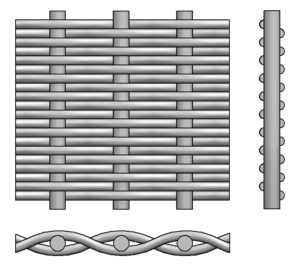
The plain Dutch woven mesh pattern is a popular and versatile wire pattern used in industrial filtration applications. This wire pattern is similar to the plain weave pattern, but with much greater warp wires and a tighter weave. The plain Dutch weave is a more complex weave pattern compared to other wire mesh patterns, but it provides numerous advantages that make it ideal for various filtration and sieving applications.
The plain Dutch woven wire mesh pattern has a unique structure where the warp wire diameter is larger than the weft wire diameter, resulting in a tightly woven wire mesh. Additionally, the weft wire mesh count is higher than the warp wire mesh count. The tightly woven structure provides superior filtration and sieving capabilities that other wire mesh patterns cannot match.
Due to the larger diameter of the warp wires, the plain Dutch woven wire mesh is more resistant to abrasion and has a longer lifespan compared to other wire mesh patterns. The tightly woven pattern also provides a uniform and smooth filtration surface, enhancing the filtering efficiency of the mesh. The plain Dutch weave wire mesh pattern is commonly used in industrial applications where high precision and reliable filtration are required.
The plain Dutch weave wire mesh pattern finds application in various industries, including chemical, food, and pharmaceutical. In the chemical industry, plain Dutch woven wire mesh is used to filter and separate different chemicals during the production process. In the food industry, the wire mesh pattern is used to filter and purify liquids and ingredients. Similarly, the pharmaceutical industry uses plain Dutch woven wire mesh to filter and purify pharmaceutical products.
In conclusion, the plain Dutch woven mesh pattern is a reliable and versatile wire pattern that offers superior filtration and sieving capabilities in various industrial applications. The tightly woven structure, durability, and high precision make it ideal for various industrial applications.
#4 Twill Dutch Weave Wire Cloth
The Twill Dutch woven wire pattern is a highly versatile woven wire pattern that offers several advantages over other patterns in the indus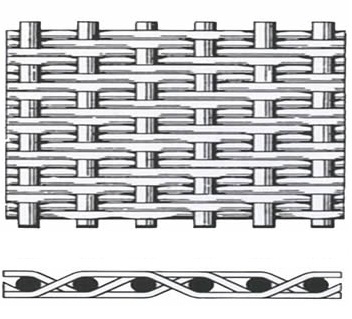 trial filtration and sieving industry. It is a unique combination of the twilled weave pattern and the Dutch woven wire pattern. This weaving style creates a tightly woven mesh with a sinuous filtration path that provides exceptional filtration capabilities.
trial filtration and sieving industry. It is a unique combination of the twilled weave pattern and the Dutch woven wire pattern. This weaving style creates a tightly woven mesh with a sinuous filtration path that provides exceptional filtration capabilities.
Compared to the Plain Dutch woven wire pattern, the Twill Dutch weave pattern has similar shute wire packing, but it is produced with double shute wires knitted in and crossed over two warp wires, and then down through another pair of warp wires alternatively. This creates a smooth surface with finer shute wires and smaller aperture sizes, making it ideal for heavy-duty filtration applications.
The Twill Dutch woven wire pattern provides superior mechanical strength, making it highly resistant to wear and tear. This makes it a popular choice in several industrial applications, including the petrochemical, food processing, and pharmaceutical industries. In addition, this pattern offers a higher loading capacity and finer aperture, making it ideal for applications that require a high level of precision and accuracy.
Overall, the Twill Dutch woven wire pattern is an exceptional choice for those looking for a robust and high-performing woven wire mesh. Its unique combination of twilled and Dutch weaving patterns provides superior filtration capabilities, making it an excellent choice for a wide range of industrial filtration and sieving applications.
#5 Reverse Dutch Weave Wire Cloth
Reversed Dutch Wo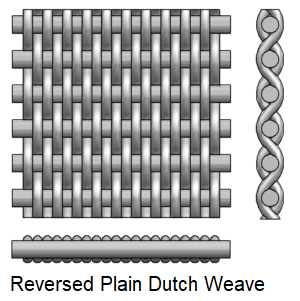 ven Wire Pattern is a highly specialized woven wire pattern used in a wide range of industrial filtration applications. This unique pattern is characterized by its reversed wire arrangement compared to its counterpart, the Dutch Woven Wire Mesh Pattern. The Reversed Dutch Woven Wire Pattern features finer stainless steel wires in the warp direction, while bigger gauged wires are used in the weft direction as shute wires.
ven Wire Pattern is a highly specialized woven wire pattern used in a wide range of industrial filtration applications. This unique pattern is characterized by its reversed wire arrangement compared to its counterpart, the Dutch Woven Wire Mesh Pattern. The Reversed Dutch Woven Wire Pattern features finer stainless steel wires in the warp direction, while bigger gauged wires are used in the weft direction as shute wires.
The Reversed Dutch Woven Wire Pattern has two different weaving types, which are reversed plain Dutch weave pattern and reversed twill Dutch weave pattern. In the reversed plain Dutch weave pattern, the weft wires are tightly pac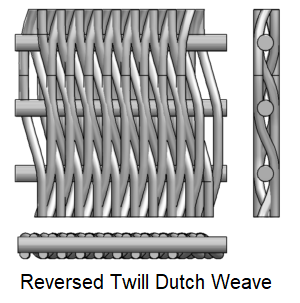 ked together to form a dense filter media. In the reversed twill Dutch weave pattern, the twill weave is used to create a more robust and sturdy woven wire pattern.
ked together to form a dense filter media. In the reversed twill Dutch weave pattern, the twill weave is used to create a more robust and sturdy woven wire pattern.
Reversed Dutch Woven Wire Cloth is widely used in the solid-liquid filtration industry due to its superior mechanical stability during backwashing, centrifugal filter cake removal, or the cleaning process. This pattern is particularly useful in applications that require high demands on filtration efficiency and mechanical strength. Its robust structure and smaller aperture sizes make it ideal for filtering out fine particles from liquids and gases. Overall, Reversed Dutch Woven Wire Pattern is an important tool in the industrial filtration industry, providing efficient and reliable filtration solutions for a variety of applications.
#6 Five Heddle Weave Wire Mesh
Five-Heddle Weave Wire Mesh, which is known by several names, including five shed woven wire mesh, five heddles woven wire mesh, 5 heddle atlas wire mesh, five shed mesh,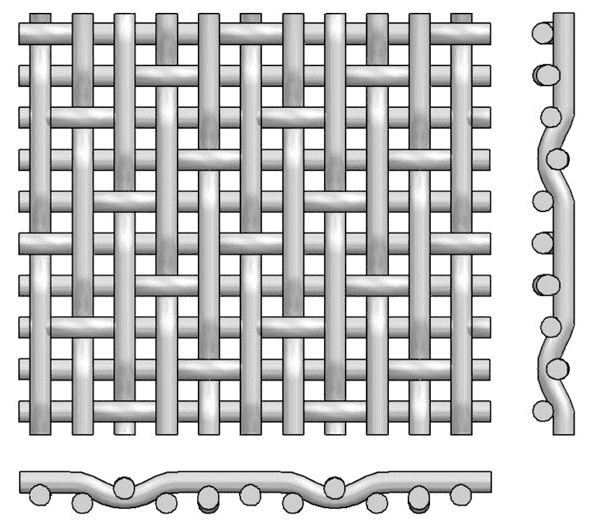 five shed twill weave mesh, five heddle wire cloth, TELA wire cloth, among others.
five shed twill weave mesh, five heddle wire cloth, TELA wire cloth, among others.
This particular wire mesh is produced by weaving stainless steel wires in a twilled pattern. During the weaving process, the shute wires are crossed over four pieces of warp wire simultaneously and then pass under one warp wire before going up through another four warp wires, and so on. This unique weaving pattern creates a smooth surface on one side of the wire mesh, which can be beneficial for filter cake removal during the filtration process.
The five-heddle weave wire mesh is suitable for various applications, including solid-liquid separation, gas filtration, and fluid filtration. Its smooth surface on one side makes it ideal for use in applications where filter cake removal is crucial, such as in wastewater treatment plants or food and beverage processing. Additionally, the twilled pattern of the wire mesh makes it strong and durable, enabling it to withstand high pressure and heavy loads, making it ideal for use in the mining and construction industries.
Plain Weave & Twill Weave Wire Mesh Specification Table.
|
/Inch |
Wire Diameter |
Aperture |
Open Area % |
Weight (LB) /100 Square Foot |
||
|
Inch |
MM |
Inch |
MM |
|||
|
1 × 1 |
.080 |
2.03 |
.920 |
23.37 |
84.6 |
41.1 |
|
2 × 2 |
.063 |
1.60 |
.437 |
11.10 |
76.4 |
51.2 |
|
3 × 3 |
.054 |
1.37 |
.279 |
7.09 |
70.1 |
56.7 |
|
4 × 4 |
.063 |
1.60 |
.187 |
4.75 |
56.0 |
104.8 |
|
4 × 4 |
.047 |
1.19 |
.203 |
5.16 |
65.9 |
57.6 |
|
5 × 5 |
.041 |
1.04 |
.159 |
4.04 |
63.2 |
54.9 |
|
6 × 6 |
.035 |
.89 |
.132 |
3.35 |
62.7 |
48.1 |
|
8 × 8 |
.028 |
.71 |
.097 |
2.46 |
60.2 |
41.1 |
|
10 × 10 |
.025 |
.64 |
.075 |
1.91 |
56.3 |
41.2 |
|
10 × 10 |
.020 |
.51 |
.080 |
2.03 |
64.0 |
26.1 |
|
12 × 12 |
.023 |
.584 |
.060 |
1.52 |
51.8 |
42.2 |
|
12 × 12 |
.020 |
.508 |
.063 |
1.60 |
57.2 |
31.6 |
|
14 × 14 |
.023 |
.584 |
.048 |
1.22 |
45.2 |
49.8 |
|
14 × 14 |
.020 |
.508 |
.051 |
1.30 |
51.0 |
37.2 |
|
16 × 16 |
.018 |
.457 |
.0445 |
1.13 |
50.7 |
34.5 |
|
18 × 18 |
.017 |
.432 |
.0386 |
.98 |
48.3 |
34.8 |
|
20 × 20 |
.020 |
.508 |
.0300 |
.76 |
36.0 |
55.2 |
|
20 × 20 |
.016 |
.406 |
.0340 |
.86 |
46.2 |
34.4 |
|
24 × 24 |
.014 |
.356 |
.0277 |
.70 |
44.2 |
31.8 |
|
30 × 30 |
.013 |
.330 |
.0203 |
.52 |
37.1 |
34.8 |
|
30 × 30 |
.012 |
.305 |
.0213 |
.54 |
40.8 |
29.4 |
|
30 × 30 |
.009 |
.229 |
.0243 |
.62 |
53.1 |
16.1 |
|
35 × 35 |
.011 |
.279 |
.0176 |
.45 |
37.9 |
29.0 |
|
40 × 40 |
.010 |
.254 |
.0150 |
.38 |
36.0 |
27.6 |
|
50 × 50 |
.009 |
.229 |
.0110 |
.28 |
30.3 |
28.4 |
|
50 × 50 |
.008 |
.203 |
.0120 |
.31 |
36.0 |
22.1 |
|
60 × 60 |
.0075 |
.191 |
.0092 |
.23 |
30.5 |
23.7 |
|
60 × 60 |
.007 |
.178 |
.0097 |
.25 |
33.9 |
20.4 |
|
70 × 70 |
.0065 |
.165 |
.0078 |
.20 |
29.8 |
20.8 |
|
80 × 80 |
.0065 |
.165 |
.0060 |
.15 |
23.0 |
23.2 |
|
80 × 80 |
.0055 |
.140 |
.0070 |
.18 |
31.4 |
16.9 |
|
80 × 80 |
.0047 |
.119 |
.0078 |
.198 |
39 |
11.39 |
|
90 × 90 |
.005 |
.127 |
.0061 |
.16 |
30.1 |
15.8 |
|
100 × 100 |
.0045 |
.114 |
.0055 |
.14 |
30.3 |
14.2 |
|
100 × 100 |
.004 |
.102 |
.0060 |
.15 |
36.0 |
11.0 |
|
100 × 100 |
.0035 |
.089 |
.0065 |
.17 |
42.3 |
8.3 |
|
110 × 110 |
.0040 |
.1016 |
.0051 |
.1295 |
30.7 |
12.4 |
|
120 × 120 |
.0037 |
.0940 |
.0064 |
.1168 |
30.7 |
11.6 |
|
150 × 150 |
.0026 |
.0660 |
.0041 |
.1041 |
37.4 |
7.1 |
|
160 × 160 |
.0025 |
.0635 |
.0038 |
.0965 |
36.4 |
5.94 |
|
180 × 180 |
.0023 |
.0584 |
.0033 |
.0838 |
34.7 |
6.7 |
|
200 × 200 |
.0021 |
.0533 |
.0029 |
.0737 |
33.6 |
6.2 |
|
250 × 250 |
.0016 |
.0406 |
.0024 |
.0610 |
36.0 |
4.4 |
|
270 × 270 |
.0016 |
.0406 |
.0021 |
.0533 |
32.2 |
4.7 |
|
300 × 300 |
.0051 |
.0381 |
.0018 |
.0457 |
29.7 |
3.04 |
|
325 × 325 |
.0014 |
.0356 |
.0017 |
.0432 |
30.0 |
4.40 |
|
400 × 400 |
.0010 |
.0254 |
.0015 |
.370 |
36.0 |
3.3 |
|
500 × 500 |
.0010 |
.0254 |
.0010 |
.0254 |
25.0 |
3.8 |
|
635 × 635 |
.0008 |
.0203 |
.0008 |
.0203 |
25.0 |
2.63 |
Plain Dutch Weave Wire Mesh Specification Table
|
Mesh Count /per inch |
Wire Diameter. (In.) |
Absolute Filtration Fineness (μm) |
Nominal Filtration Fineness (μm) |
|
8 x 85 |
.014 x .0126 |
318-340 |
250-255 |
|
12 x 64 |
.024 x .0165 |
270-285 |
200-205 |
|
14 x 88 |
.020 x .013 |
225-245 |
150-155 |
|
20 x 150 |
.0098 x .007 |
155-165 |
100-105 |
|
24 x 100 |
.015 x .010 |
115-125 |
80-85 |
|
30 x 150 |
.009 x .007 |
95-100 |
65-70 |
|
40 x 200 |
.007 x .0055 |
65-70 |
55-60 |
|
50 x 250 |
.0055 x .0045 |
55-60 |
40-45 |
|
80 x 400 |
.0049 x .0028 |
43-48 |
35-40 |
Twill Dutch Weave Wire Mesh Specification Table
|
Mesh Count /per inch |
Wire Diameter (In.) |
Absolute Filtration Fineness (μm) |
Nominal Filtration Fineness (μm) |
|
20 x 250 |
.0098 x .0079 |
110-120 |
98-105 |
|
30 x 360 |
.0098 x .0060 |
90-100 |
80-84 |
|
40 x 560 |
.0070 x .0040 |
70-75 |
47-52 |
|
120 x 400 |
.0040 x .0025 |
50-55 |
37-43 |
|
120 x 160 |
.0040 x .0025 |
40-45 |
28-32 |
|
80 x 700 |
.0040 x .0030 |
35-40 |
24-26 |
|
200 x 600 |
.0024 x .0018 |
28-32 |
19-21 |
|
165 x 800 |
.0028 x .0020 |
24-26 |
14-16 |
|
165 x 1400 |
.0028 x .0016 |
16-18 |
9-11 |
|
200 x 1400 |
.0028 x .0016 |
12-14 |
5-6 |
|
250 x 1400 |
.0022 x .0016 |
11-12 |
3-4 |
|
325 x 2300 |
.0015 x .0010 |
8-9 |
2-3 |
Reverse Dutch Weave Wire Mesh Specification Table
|
Mesh Count / per inch |
Wire Diameter (in.) |
Wire Diameter (mm) |
|||
|
Warp |
Weft |
Warp |
Weft |
Warp |
Weft |
|
72 |
15 |
0.018 |
0.022 |
0.45 |
0.55 |
|
120 |
15 |
0.014 |
0.018 |
0.35 |
0.45 |
|
132 |
17 |
0.013 |
0.018 |
0.32 |
0.45 |
|
150 |
17 |
0.012 |
0.018 |
0.3 |
0.45 |
|
152 |
24 |
0.011 |
0.016 |
0.27 |
0.4 |
|
152 |
30 |
0.01 |
0.012 |
0.25 |
0.3 |
|
170 |
17 |
0.011 |
0.018 |
0.27 |
0.45 |
|
260 |
40 |
0.006 |
0.01 |
0.15 |
0.25 |
|
350 |
40 |
0.005 |
0.009 |
0.12 |
0.23 |
Five Heddle Woven Wire Mesh Specification Table
|
Mesh Count / per inch |
Wire Diameter (mm) |
Micro Retention |
Thickness |
Approx.Weight |
|||
|
Warp |
Weft |
Warp |
Weft |
abs. μm |
nom. Μm |
mm |
Kg/m2 |
|
30 |
18 |
0.5 |
0.5 |
0.60-0.65 |
0.37 |
1.48 |
3 |
|
28 |
17 |
0.47 |
0.47 |
0.75-0.80 |
0.46 |
1.41 |
2.53 |
|
24 |
20 |
0.6 |
0.6 |
0.65-0.75 |
0.49 |
1.7 |
3.96 |
|
15 |
13 |
0.9 |
0.9 |
1.15-1.20 |
0.85 |
2.6 |
5.67 |
|
80 |
60 |
0.2 |
0.2 |
0.20-0.22 |
0.127 |
0.55 |
1.4 |
|
77 |
40 |
0.24 |
0.24 |
0.38-0.40 |
0.095 |
0.68 |
1.65 |
|
65 |
36 |
0.3 |
0.3 |
0.26-0.29 |
0.1 |
0.84 |
2.27 |
|
55 |
36 |
0.3 |
0.3 |
0.25-0.28 |
0.175 |
0.84 |
2.05 |
|
132 |
85 |
0.14 |
0.2 |
0.09-0.11 |
0.052 |
0.44 |
1.47 |
|
107 |
132 |
0.16 |
0.14 |
0.055-0.065 |
0.055 |
0.44 |
1.3 |
|
107 |
125 |
0.16 |
0.14 |
0.065-0.08 |
0.07 |
0.45 |
1.27 |
|
107 |
59 |
0.16 |
0.16 |
0.16-0.18 |
0.077 |
0.45 |
1.09 |
METART produces square-hole stainless steel woven wire mesh ranging from 1 mesh to 635 mesh. For most of the specifications, we will regularly keep them in stock in order to guarantee a quick delivery service. And we produce dutch woven wire mesh up to 2300Mesh. All the wire meshes are produced according to international quality standards including DIN, ASTM and ISO standards.
Hot Sale Products
#40Mesh Square Hole Stainless Steel Wire Mesh
#50Mesh Square Hole Stainless Woven Wire
#60Mesh Stainless Steel Wire Mesh
#80Mesh Stainless Steel Wire Cloth
#100Mesh Stainless Steel Wire Cloth
#120Mesh Stainless Steel Wire Cloth
#150Mesh Stainless Steel Wire Cloth
#160Mesh SS Wire Cloth
#180Mesh SS Wire Cloth
#200Mesh Woven Wire Cloth
#250Mesh Stainless Steel Filter Mesh
#300Mesh Fine Stainless Steel Wire Cloth
#325Mesh Fine Wire Cloth
#400Mesh Super Fine Filer Wire Cloth
1. Industrial filtration in oil, gas, and chemical industries:
Stainless steel wire mesh can be used in various types of filters for these industries, including cartridge filters, bag filters, and disc filters. The mesh is capable of filtering out impurities in liquids and gases, ensuring the smooth operation of industrial processes.
2. Freshwater processing and wastewater processing:
Stainless steel wire mesh can be used in the production of filters for removing impurities from water, including sand and other particles. It can also be used as a support layer in membrane filters used in wastewater processing.
3. Sieving and separating in the quarrying and mining industry:
Stainless steel wire mesh can be used as a screen in the quarrying and mining industry to sort materials of different sizes. It can also be used as a filter medium to separate liquids and solids.
4. Agricultural uses and food processing industry:
Stainless steel wire mesh can be used in the production of filters for separating solids from liquids, removing impurities from liquids, and processing food products such as grains and flour. It can also be used in livestock enclosures, and as a support structure for fruit and vegetable harvesting.
5. Architectural purposes:
Stainless steel wire mesh can be used in architectural applications such as cladding, facades, and balustrades, and as a decorative material for building interiors.
6. Industrial filters including common filter cylinders, filter discs, drum filters, cartridge filters, and vertical pressure leaf filters:
Stainless steel wire mesh is used as a filter medium in all of these types of filters, providing excellent filtration performance and durability.
In summary, stainless steel wire mesh is a versatile material with a wide range of applications, particularly in filtration, separation, and sieving. It is used in various industries, including oil and gas, chemicals, mining, agriculture, and food processing, as well as in architecture and building construction.
©COPYRIGHT METART BUILDING TEC CO., LTD | ALL RIGHTS RESERVED | PRIVACY POLICY